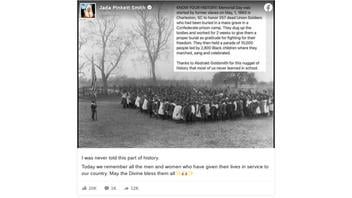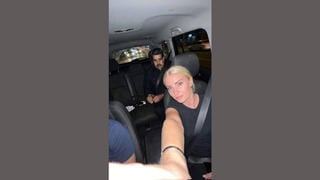
Did formerly enslaved Black people start Memorial Day in the U.S.? Evidence suggests that they may have: A celebration on May 1, 1865, is considered one of the first mass memorializations of fallen soldiers in the country. The celebration was organized and attended by formerly enslaved Black people who, along with white sympathizers, honored Union soldiers who died in the American Civil War.
However, historians have yet to confirm which Memorial Day celebration was actually the first.
The claim appeared in a Facebook post (archived here) published on May 31, 2021, on the page of actress Jada Pinkett Smith. The graphic featured a black and white image of Black children saluting a U.S. flag held by a Black boy. The graphic read:
KNOW YOUR HISTORY: Memorial Day was started by former slaves on May, 1, 1865 in Charleston, SC to honor 257 dead Union Soldiers who had been buried in a mass grave in a Confederate prison camp. They dug up the bodies and worked for 2 weeks to give them a proper burial as gratitude for fighting for their freedom. They then held a parade of 10,000 people led by 2,800 Black children where they marched, sang and celebrated.
The caption of the post read:
I was never told this part of history.
Today we remember all the men and women who have given their lives in service to our country. May the Divine bless them all✨🙌🏽✨
This is what the post looked like on Facebook on June 2, 2021:
(Source: Facebook screenshot taken on Wed Jun 2 20:39:50 2021 UTC)
The origins of Memorial Day have been contested throughout history, with many locations claiming to have started the celebration. The oft-told account of the start of the holiday was that it was an order created by Maj. Gen. John A. Logan, a Union general, in 1868.
However, Waterloo, New York, was recognized by the federal government in 1966 as the "birthplace" of Memorial Day. The town reportedly held what is considered the first mass memorialization of fallen soldiers on May 5, 1866, although some evidence suggests that the celebration did not actually happen until a few years after the 1866 date.
Other small towns across the country claim that the founding of the celebration is a part of their history. In October 1864, women in Boalsburg, Pennsylvania, reportedly decorated the graves of fallen soldiers from the Civil War along with those from the War of 1812 and the Revolutionary War. There is also an ongoing historical dispute between Columbus, Mississippi, and Columbus, Georgia, about which town celebrated an iteration of Memorial Day first in 1866.
The Charleston celebration is unique because it was launched by the newly freed Black residents of the city. David W. Blight, a professor in the department of history at Yale University, uncovered this long-forgotten history in his 2001 book "Race and Reunion: The Civil War in American Memory." The celebration was held on the Washington Race Course and Jockey Club, where Confederate forces had kept Union soldiers imprisoned. More than 250 Union soldiers died in the outdoor prison from disease and were buried in a mass grave behind the facility. Dozens of Black residents in Charleston decided to give those soldiers a proper burial. The creators of the gravesite marked the location with the words "Martyrs of the Race Course."
Blight further discussed the Charleston event in a 2011 opinion piece in the New York Times:
The symbolic power of this Low Country planter aristocracy's bastion was not lost on the freedpeople, who then, in cooperation with white missionaries and teachers, staged a parade of 10,000 on the track. A New York Tribune correspondent witnessed the event, describing 'a procession of friends and mourners as South Carolina and the United States never saw before.'
The procession was led by 3,000 black schoolchildren carrying armloads of roses and singing the Union marching song 'John Brown's Body.' Several hundred black women followed with baskets of flowers, wreaths and crosses. Then came black men marching in cadence, followed by contingents of Union infantrymen. Within the cemetery enclosure a black children's choir sang "We'll Rally Around the Flag," the "Star-Spangled Banner" and spirituals before a series of black ministers read from the Bible.
After the dedication the crowd dispersed into the infield and did what many of us do on Memorial Day: enjoyed picnics, listened to speeches and watched soldiers drill. Among the full brigade of Union infantrymen participating were the famous 54th Massachusetts and the 34th and 104th United States Colored Troops, who performed a special double-columned march around the gravesite.
However, the celebration seems to have been left out of discussions about early observances of Memorial Day. In a 2015 article for The Star-Ledger, Blight noted:
According to a reminiscence written long after the fact, "several slight disturbances" occurred during the ceremonies on this first Decoration Day, as well as 'much harsh talk about the event locally afterward.' But a measure of how white Charlestonians suppressed from memory this founding in favor of their own creation of the practice later came fifty-one years afterward, when the president of the Ladies Memorial Association of Charleston received an inquiry about the May 1, 1865 parade. A United Daughters of the Confederacy official from New Orleans wanted to know if it was true that blacks had engaged in such a burial rite. Mrs. S. C. Beckwith responded tersely: 'I regret that I was unable to gather any official information in answer to this.' In the struggle over memory and meaning in any society, some stories just get lost while others attain mainstream dominance.
In an email to Lead Stories on June 2, 2021, Blight discussed whether he believes the Charleston celebration "started" Memorial Day or if it was one of the earliest iterations of the holiday:
The answer is really both. Your [sic] was started by black folk in Charleston as a mass ritual but was also part of other smaller efforts to honor the dead at battlefields and cemeteries, North and South in the coming year.
Today, even the official history of Memorial Day as told by the Department of Veterans Affairs fails to acknowledge the Charleston celebration.
Although the Charleston event could be considered the first Memorial Day celebration, one part of the Facebook claim is not correct. The image used to convey the information about the claim is not from the Charleston celebration: Rather, it is an image taken in 1899 showing Black schoolchildren saluting the U.S. flag at Whittier Primary School, located in Hampton, Virginia.















